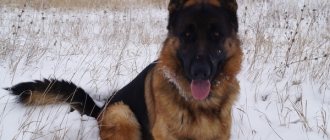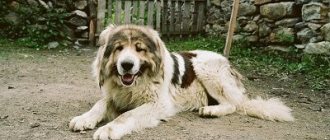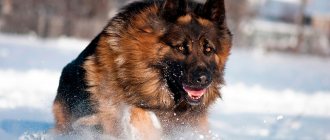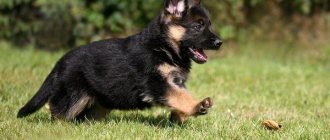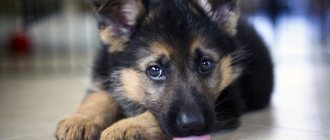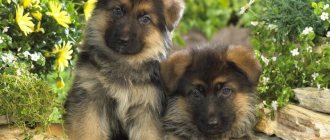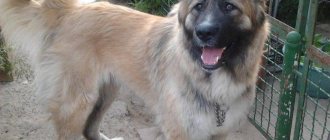The Miniature American Shepherd was developed in the United States in the second half of the 20th century. This is a very energetic and sociable dog that has strong herding instincts, but is primarily seen as a companion for active people. Easy to train, hardy and sociable. Suitable for most types of canine sports. Requires simple but regular care. Previously, the breed was called the Miniature Australian Shepherd or Mini Aussie.
Origin story
The Miniature American Shepherd is one of the youngest breeds. She was bred in the 60s in California by selecting small Australian Shepherds. According to some reports, they were infused with the blood of various small dogs, similar in phenotype. Doris Cordova of Nork, California, was one of the first to breed miniature Aussies.
The goal of breeding a Miniature American Shepherd is to create a dog with the activity level, intelligence and talents of an Australian Shepherd, but in a smaller size.
Initially, the breed was called the Miniature Australian Shepherd, then it was renamed the North American Shepherd and finally the Miniature American Shepherd. In 1990, a breed club was created. The American Kennel Club (AKC) began registering the MAO in 2011, and the breed received official recognition in 2015.
The history of the origin of miniature American Shepherds is inextricably linked with the history of Australian Shepherds (Aussies).
A Brief History of Norwegian Shepherds
The Norwegian Shepherd is a direct descendant of ancient dogs that accompanied the Vikings on campaigns and lived with them in settlements. Used as a shepherd, guard, and kept on large and small farms.
Burials found in large numbers included dogs, indicating their closeness to humans. Burying an animal and its owner together was considered a special privilege.
"Buhund" is translated from Norwegian as a farmer's dog. The first official club was opened in Norway in the 20s. By the end of 1945, the first standard and official recognition appeared. In the late 80s, Norwegian puppies came to America, where they earned attention due to their performance characteristics.
Appearance
The Miniature American Shepherd is a small dog with a strong, proportional build, but not heavy. Has exceptional maneuverability combined with endurance. Sexual dimorphism is pronounced.
- Height at withers - 35-46 cm;
- Weight - 9-14 kg.
The head is well defined and dry. The eyes are almond-shaped, can be of any color, heterochromia occurs. The ears are triangular, set high, of medium size, raised on cartilage or pulled back in a “rose” shape. Nose with well-developed nostrils, any color. The neck is strong and well set on the shoulders.
The case is strong and has a moderately stretched format. From the withers to the lower back, the back is straight both when standing and in motion. The croup is moderately sloping. The front legs are of medium length, straight, parallel, with well-developed hips. The tail may be long or short from birth. Sometimes it stops short.
Double wool. The awn is of medium length and texture, straight or slightly wavy. The undercoat is short, soft and dense. Colors:
- Red and white;
- Marble;
- Brown tricolor;
- Black tricolor;
- Marble blue.
general characteristics
Used for various purposes. She is brought in as a guard for a house or property, or as a guard for animals during grazing. The dog easily finds his way home after a walk in the mountains or in the forest, so it will also come in handy as a guide or assistant on a hunt. However, they are rarely brought in to participate in exhibitions and competitions.
It is recommended for various families, but if there is a child in the house who really likes to play with animals, this can become a problem. Himalayans are very sociable, but do not like excessive attention, they just get the job done. So children can throw them off balance.
According to the description, the dog’s height ranges from 51-66 cm at the withers, and its weight is 23-41 kg.
Character and behavior
MAO has a balanced, pleasant character. This is an intelligent, loyal dog, energetic and friendly, full of enthusiasm and curiosity. Very sociable and social, gets along well with other pets, including dogs and cats, especially if she grew up with them. Patient with small children, older children will be a companion in games.
The Miniature Shepherd should primarily be considered as a versatile working dog and companion for active people. And not as a decorative animal for an apartment and rare walks.
The Miniature Australian Shepherd loves to work and wants to be useful. She enjoys time with her owner and wants to train and compete. She often enjoys performing various search and fetch tasks, and her vocabulary can be as large as that of a border collie. Responds best to positive training methods. When communicating with a mini shepherd, you should avoid cruelty and injustice.
Training begins as early as possible; early socialization is very important, without which the dog can grow up nervous or shy. He usually does not show shyness with strangers. It has a guard instinct, but is not capable of guarding due to its size and friendliness.
The Miniature American Shepherd is suitable for various sports: agility, obedience, herding, search, rally.
Description of the breed
According to standard No. 237, the Norwegian Buhund belongs to the 5th group “Spitz and primitive breeds” and the 3rd section “Northern guard and herding dogs”. At one glance at the representative, it becomes clear why the breed is classified specifically in this group - in appearance, the features inherent in Spitz are immediately recognizable. The purpose of Norwegian Shepherds is guarding, herding and farming, and in addition to this, they become excellent companions for humans.
External parameters of the dog
The appearance, described in detail in the standard, has a number of required parameters:
- the head should be proportional to the size of the body, not too large, wedge-shaped;
- the skull is flat, and the line of transition from the forehead to the nose is clear, but not sharp;
- a not very narrow muzzle should be approximately the same length as the skull itself;
- nose, eyelids and lips must be black;
- the eyes are oval, the color is as dark as possible;
- ears are medium-sized, pointed and erect;
- the neck is strong, the back is not too long, but always straight and strong;
- the tail should be curled and set high, tending towards the center of the back and without a strong bend to one side;
- The limbs are strong and strong, and the paws are oval-shaped with compactly collected toes.
The breed is characterized by pronounced sexual dysmorphism, that is, there are significant anatomical differences between females and males of Buhunds, in particular regarding size.
Males should be in the range of 43-47 cm in height at the withers, and females - 41-45 cm. In terms of weight, Norwegian Shepherds can be classified as medium: for males - 14-18 kg, and for females - 12-16 kg . The dogs move actively, easily, without heaviness in their steps.
The coat of Buhunds is quite thick and stiff, but at the same time smooth. The length depends on the part of the body: on the head and front of the limbs the hairs are shorter, but on the chest, neck, tail and hips they are much longer. Dogs are well adapted to low temperatures and have a dense, soft undercoat. There are two color options:
- wheat of different saturations (from pale beige to rich yellow-red);
Buhunds are allowed all colors in the beige-red range
- black (the more uniform and deeper the better).
The Buhund's coat can be dyed a rich black color.
In light colors, the presence of a mask is allowed, as well as black tips on the hairs, but they should not affect the main color of the animal.
Character and psyche of the breed
Buhunds are courageous, proud and friendly dogs. Both puppies and adults of the Norwegian breed are very energetic and love to participate in active games. The animal’s balanced psyche makes it an excellent family dog; the Buhund will be able to play with children for hours, including in the fresh air. Norwegian Shepherds have a special connection with their owner - they always try to please their leader, including by flawlessly following commands. A properly raised, socialized pet will calmly react to other family members - dogs, cats and other pets.
Bukhunds get along well with other dogs and other pets
Despite their good nature, Norwegian Buhunds are far from harmless. If necessary, sensing danger, representatives of the breed show aggression, and treat all strangers with suspicion. To avoid problems, the owner must treat his dog carefully, devoting time to both training and quiet time. Representatives of the breed will not tolerate aggression and unfair behavior.
Disqualities and disadvantages
The disadvantages of a particular representative of the breed are deviations from the standard. The following are considered serious disadvantages:
- too rough appearance, lack of elegance;
- pink or brown nose;
- light-colored eyes;
- bulging eyes;
- poor tail curl;
- short step;
- increased nervousness of the animal.
A number of inconsistencies with the standard of the Norwegian Buhund may make it generally unsuitable for exhibition activities and breeding work. Disqualifying signs:
- behavioral deviations, in particular severe aggression or fearfulness, shyness;
- malocclusion;
- drooping ears;
- coat color that does not meet breed requirements;
- height deviation (lower by more than 1 cm and higher by more than 2 cm).
Content Features
The miniature Australian Shepherd adapts well to life in an apartment and in a private house, provided it is regularly walked. In addition, it is important to provide a smart dog with sufficient mental stress (training, new tasks and commands). Physical activity should be very good, at least 2-3 hours of active walking a day. MAO can become a companion for jogging and cycling.
Care
The miniature shepherd has a rather long double coat, which sheds heavily (heavily in spring and autumn, moderately throughout the year), and is prone to tangling and matting, so it is recommended to brush the dog 1-2 times a week or more often.
There is no need for regular haircuts. For exhibitions, the body coat is slightly trimmed and milled for a more neat appearance. Bath the dog as needed, usually once every 7-10 days or less. Dog grooming also includes trimming nails, cleaning ears and teeth.
Training
For better education, an age from 3 to 4 months is suitable; it is recommended to start training with the easiest commands, gradually increasing the intensity and duration.
The owner of the pet must be involved in the upbringing, otherwise nothing will come of it.
At the initial stage, you need to spend 10 -20 minutes a day, after 6 - 7 months, begin active learning. You can go through special programs with a specialist, and then continue studying on your own.
Health and life expectancy
The Miniature American Shepherd is a healthy breed. O life expectancy is 12-15 years.
However, hereditary diseases occur in some lines:
- Ophthalmological diseases (progressive retinal atrophy, collie eye anomaly, cataracts);
- Hip dysplasia;
- Patella dislocation;
- Elbow dysplasia;
- Degenerative myelopathy.
Without enough exercise and an unbalanced diet, Miniature American Shepherds are prone to obesity and its associated diseases.
Norwegian Shepherd Health
By nature, the dog has good immunity, without a large number of serious diseases. There are some predispositions:
- Dysplasia of large joints;
- Diseases of the visual organs in adulthood;
- Otitis;
- Food allergies;
- Diseases of the endocrine system;
- Gastrointestinal diseases.
- Life expectancy: from 12 to 16 years. With proper care and good nutrition, your pet will live a full, long life, perhaps without getting sick at all.
Pros and cons of the breed
Among the advantages of the breed are:
- loyalty;
- affection;
- lively temperament;
- reasonableness.
disadvantages , but you need to pay attention to them:
- need for a leader;
- touchiness.
